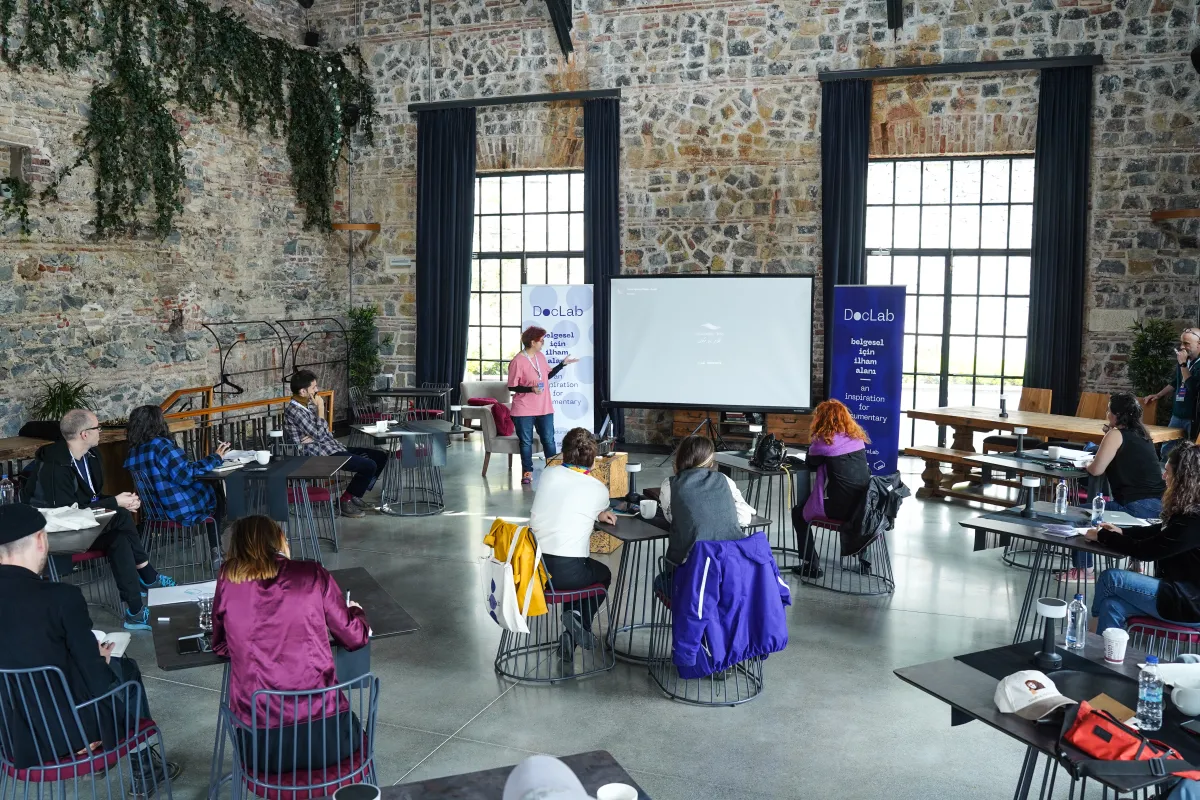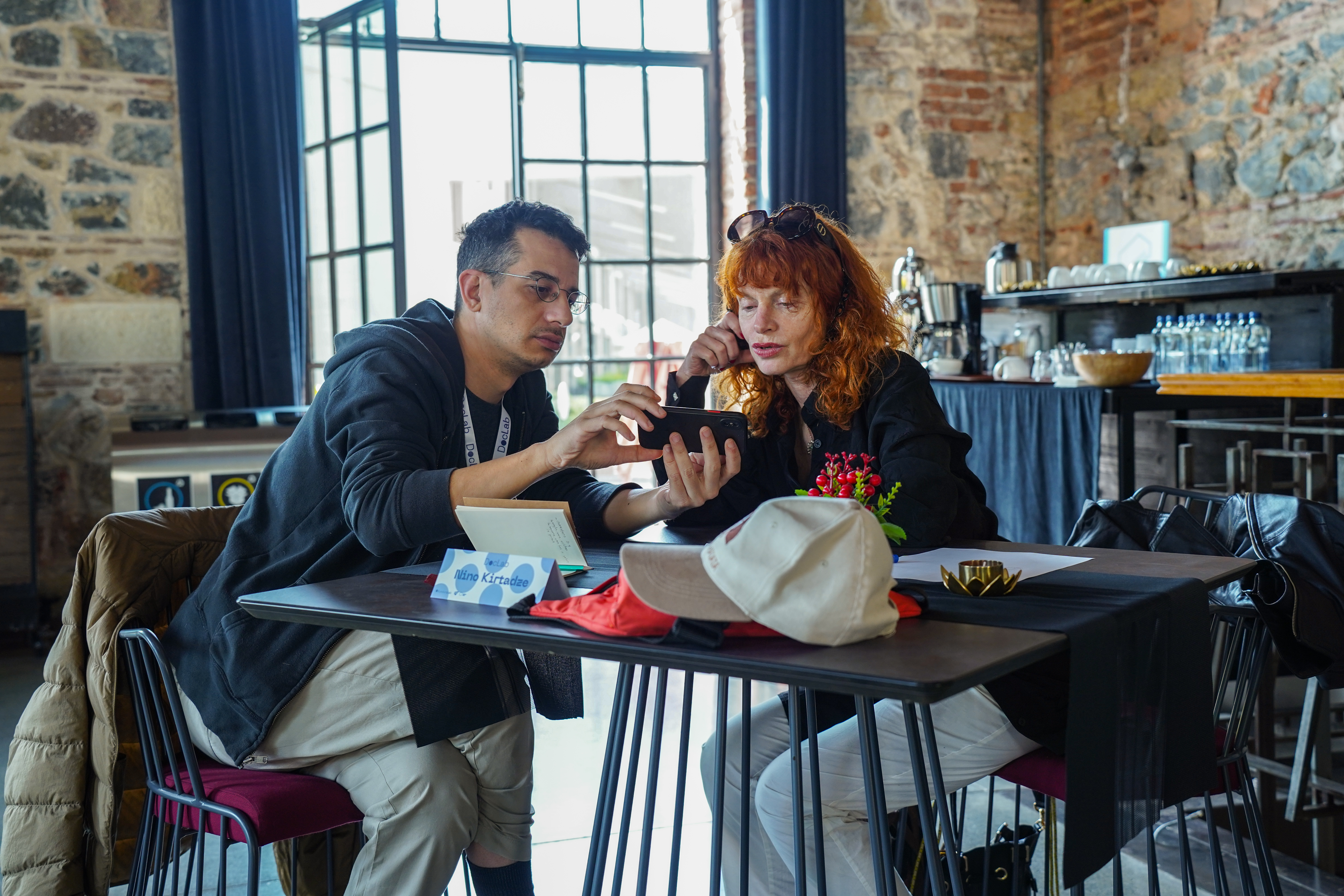

Image credit: Beykoz Kundura DocLab
Like other languages, filmmaking is one that is learned but also raised in historical, societal, and cultural patterns. As Augusto Boal posits in his book Theatre of the Oppressed, “By learning a language, a person acquires a new way of knowing reality and of passing that knowledge on to others.” In May 2023, Kundura DocLab brought together documentary theater- and filmmakers from Turkey and surrounding countries to explore the intersections of the two practices and encourage new languages.
Connecting Documentary Theater and Documentary Film
An initiative of Beykoz Kundura, an arts and cultural center in Istanbul, the DocLab’s first edition invited ten artists, half in each practice, for a one-week intensive workshop and creative incubator at the center’s campus in Beykoz. The program was designed as a mix of practical training sessions, project sharing, and personal exercises and exploration.
Anthropology has used both film and theater as tools to conduct and visualize research, and so it is fitting that documentary film can take inspiration from theater and vice versa. In the DocLab’s service region, which includes Turkey, Lebanon, Israel, Iran, Georgia, and Romania, strong storytelling language and creativity exist, in addition to histories of conflict, political challenges, and claims for freedom. How do filmmakers preserve their own narratives and creativity when many of the opportunities for funding or distribution expect certain subjects or styles?
Creating opportunities within the region allows filmmakers to explore their creativity in safe spaces without the pressures of always having to be “the other” in an industry, instead shifting the frame of reference to themselves (as explored in a recent IDA panel). At a session at Cannes Doc Day, Mehret Mandefro described “the distinction between the West and the rest being replaced by a multipolar world where the cultural influence of ‘the rest’ is rising.” This space allows for new languages to emerge; Kundura DocLab encouraged the possibilities of a more interdisciplinary approach to making nonfiction work and, subsequently, as Boal encourages, new forms of making “thought visible.”
Says artistic director Buse Yıldırım,
We wanted to open a space for peer-to-peer exchange from makers of both genres. The driving force into pursuing research or looking into nonfiction elements of storytelling are common aspects of documentary theater and documentary film. We create neither boundaries nor rigid definitions; we enjoy ambiguity and experimenting at the early phase of developing the projects. Film and theater can be an outcome or a tool, or a method to convey stories in documentary art.
Yıldırım has long seen value in the principles of interdisciplinary work. “While I am attending theater festivals, I observe filmic elements in the performances that push me to explore [this relationship] more in-depth.” Last year, Beykoz Kundra collaborated with Rimini Protokoll (a leading German artist collective of documentary theater) for Remote Istanbul, an immersive audio walk in the streets of Istanbul where spectators became participants as “the camera/cameraman.”
For the theater side of the workshop, DocLab hosted a performance of Pleasant Island by Silke Huysman and Hannes Dereere, who also served as mentors for the dramaturgs. Their piece uses their personal smartphones to navigate the spectator through audio and images from their research on Nauru Island and present them on stage, standing alongside large screens that feature audio, video, images, and messages. None of the Lab’s film participants had been familiar with documentary theater. Participating filmmaker Can Eskinazi was inspired by thinking about the resultant possibilities. He had worked and collaborated with theater before, but “the coming up with ideas, the process of documentary theater was more open-minded in [Silke and Hannes’] approach. They know it’s going to be a play but not what form it will take until after the research is finished. I learned new ways of approaching a story.”
Lebanese filmmaker Niam Itani agreed that the inclusion of theater allowed the group to think beyond the form itself:
It’s very similar, actually—in developing the ideas and then thinking how to stage it or what elements to bring from the field onto the stage. But Silke and Hannes have used a lot of what they brought from the field—voice recordings, videos, and images—and their presence on stage and display was very minimal. So it was, in a way, similar to documentary film. Their presence was important because they were the link to these other voices and videos. It's not very different from a [film] process.
Documentary theater and documentary film share the language of reality, and while they take different forms, they are informed by similar approaches to gathering knowledge, investigating aesthetics and style to share experiences. While DocLab was project-based, the goal was to not merely focus on project development but also expand artists’ understandings of methodology and aesthetics in research-led practice. This meant sessions with anthropologists, sociologists, actors, filmmakers, playwrights, and directors of both film and theater as instructors. On the documentary film side, director Nino Kirtadze shared her own techniques, artistic choices, and view of what’s happening in today’s documentary world. As an actress herself, she was excited to create a “crossroads of different sensibilities,” a place where practices and people across a wide spectrum of perspectives can meet. She emphasizes her instructions were just tools. “There should be no recipes. Each story needs its own way to be told.”

“I’m interested in finding ways of approaching reality, and then the question is how to reproduce or present them in art,” shares Aljoscha Begrich, dramaturg and DocLab advisor. “The way of looking at reality and how to consider my surroundings is more important than the form in which it is presented later. All these documentary forms are very close to each other. This is also what I like so much about DocLab: the difference between the genres is minimized, while the difference in the way of conceiving the world is maximized.”
Solidarity Across Geography
Despite the national and international success of Turkish documentary films, from makers both based in the country and expatriates, there are still few spaces for learning and sharing. Nonfiction filmmaking communities and industries are by no means absent in the Southwest Asia and North Africa (SWANA) region, but many countries lack film production and distribution infrastructure. Development opportunities are a luxury. Workshops and labs are scarce and often unstable, offered briefly, and abandoned based on unreliable funding priorities and the absence of support organizations. Any lab and workshop opportunities are widely appreciated not only for project progress but also for the building of networks and community.
With scant funding opportunities from within SWANA, many filmmakers must seek support outside their home countries. That means looking mostly towards Western and Central Europe or the Gulf states. Despite the support from industry mentors, sometimes this means being pushed by funders and gatekeepers into boxes—films about politics and national and cultural identities. “For instance, most people want a film from Iran to be related to the ‘real world’ events, but when it’s only timely, it’s soon forgotten, as another conflict arises,” notes Nino. “It often doesn’t take you anywhere; there’s a danger of staying on the surface.” For her, the value comes from finding something “on the side.”
For filmmakers in this region, making films is “about protecting their own cultural heritage,” says Sigal Yehuda, the director of Close-Up, another artist and film development initiative. “With all the complexities, of course they need support from the West, but they also challenge the West to look at them differently.” Close-Up has run yearly since 2019 (and its previous form, Greenhouse, since 2007). Its very intensive program spans over a year and supports selected directors by focusing on developing their stories and readying the film for the next step. Nino, who is also an advisor for Close-Up, again stresses that this program is not about imposing a European style on the projects, but rather helping the filmmakers to “know better what they want to get out of the film.” The program, originally open to SWANA filmmakers and featuring mentors from both those regions and Europe, has now expanded to include the South Caucasus.
The benefit of having an underdeveloped documentary industry could mean that a “language” for nonfiction filmmaking hasn’t yet been set. For filmmakers working outside the box, creative documentary approaches that give them more freedom have been increasingly touted as a moral, financial, and aesthetic alternative to the inundation of a standard form encouraged by the rise of corporate streaming and the so-called “golden age” of documentary. Can notes the proliferation of streaming allows not only for international films to be seen by Turkish filmmakers but for their own films to reach both local and international audiences, providing a new incentive. “In Turkey we can find new solutions and new forms that are both familiar and strange. We can do this in the documentary world now.”
Yıldırım doesn’t believe there is a specific style of storytelling either in the region or that those outside the region expect to see from it. “In DocLab, we create neither boundaries nor rigid definitions,” she says. The regional angle serves more to reinforce transcultural production. But there is still value in developing a lab focusing on artists from a loosely defined region. It’s not just style, it’s also solidarity. This landscape is a complicated geography in terms of people, politics, representation, and positions of power. This affects how makers are seeing each other’s projects, feeling solidarity from similar politics, states of expression, and expectations.
Kundura DocLab staff, says Niam,
were trying to actually design this in a different way. For example, in the previous labs we participated in, the mentors would be from the North and the participants from the South. So there was always a huge disconnect. For this one, they made sure to pick a specific geographic region for people to apply from and then they tried their best to bring mentors and people to speak who are either from the same region or as close as possible.
In creative industries and practice, artists are often alone. Bringing together artists from similar cultural contexts creates an intrinsically supportive space, where their different disciplines and approaches can challenge each other to think in new ways. While labs don’t directly lead to commercial or critical success and can only serve a handful of makers at a time, the value in their experiences is in artists carrying forth that spirit of new concepts and mentorship. DocLab would like to build an artist community that could potentially collaborate and co-produce interdisciplinary nonfiction work. In the meantime, it will continue to nurture the creative documentary ecosystem with a series of documentary screenings reflecting different styles of nonfiction.
Karen Cirillo is a cultural worker, documentary programmer and producer, and writer. She is currently based in Istanbul, where she creates multimedia work and events, writes, and manages visual projects for UNDP and other organizations.




